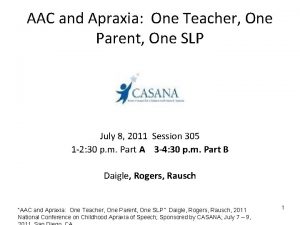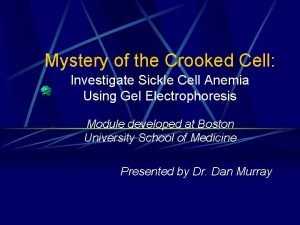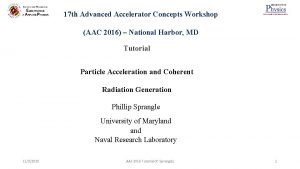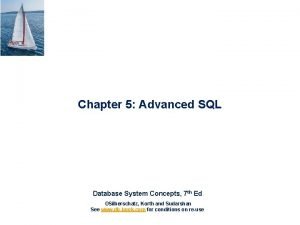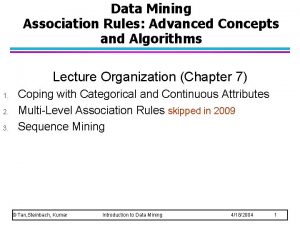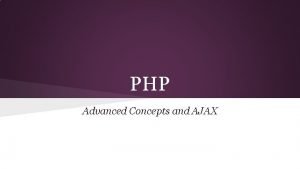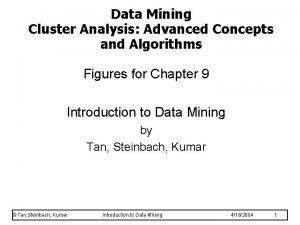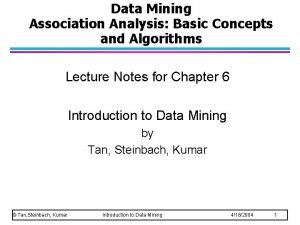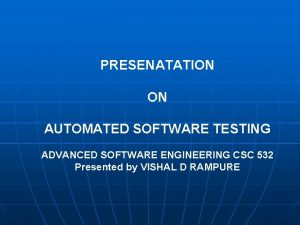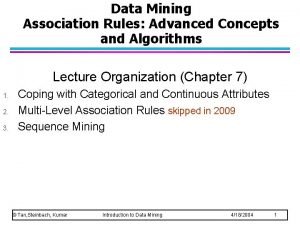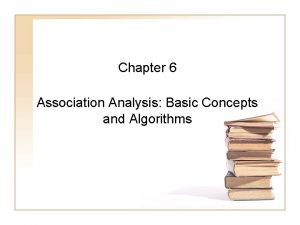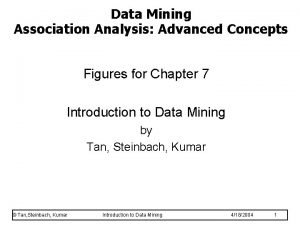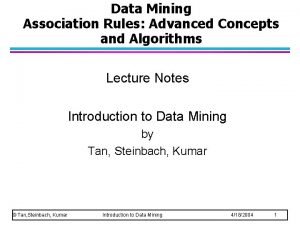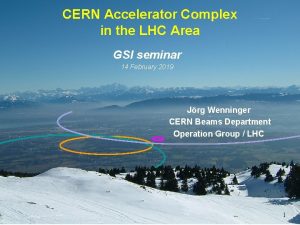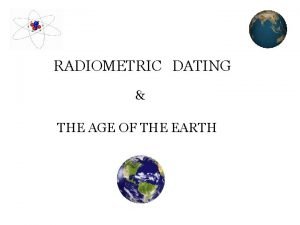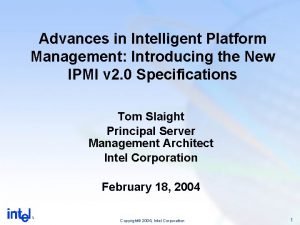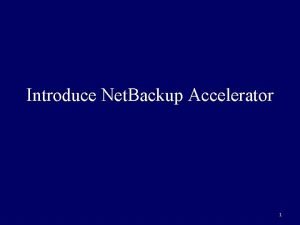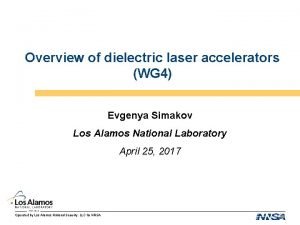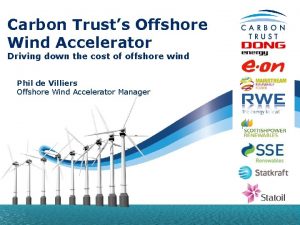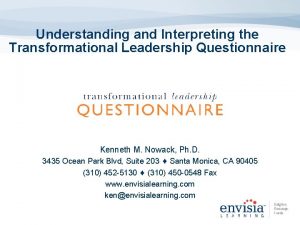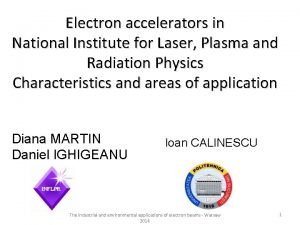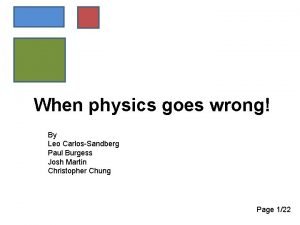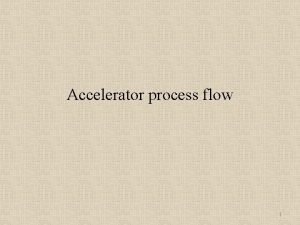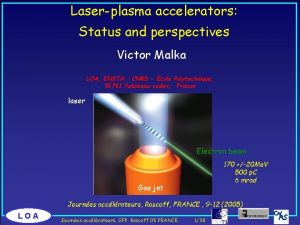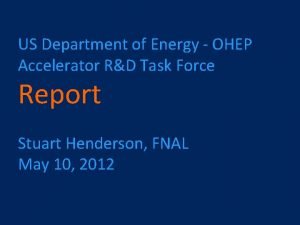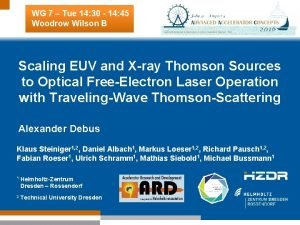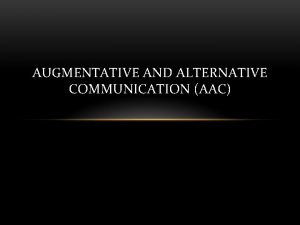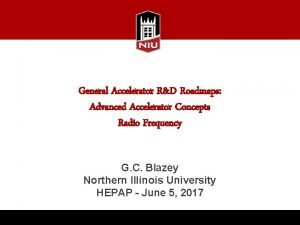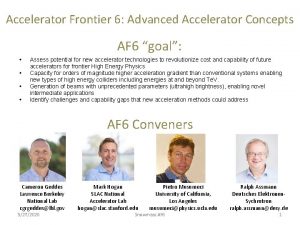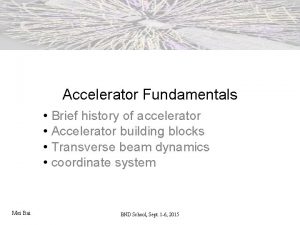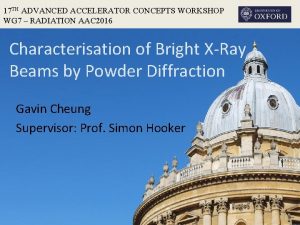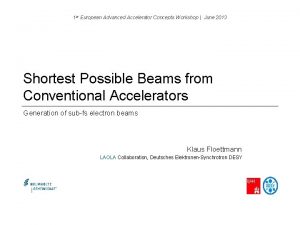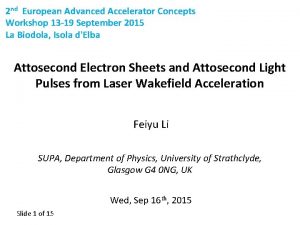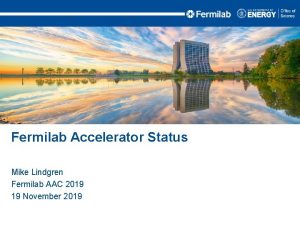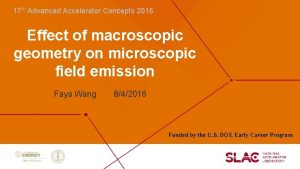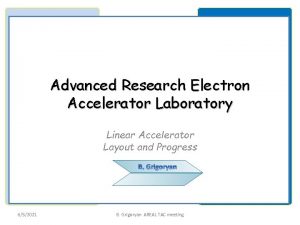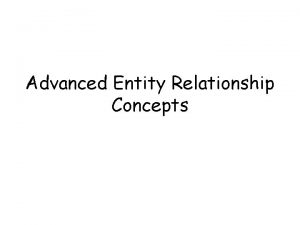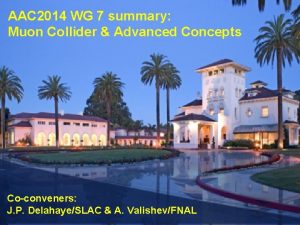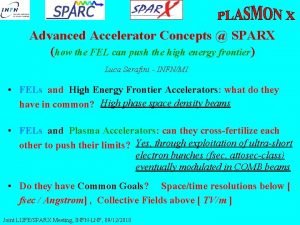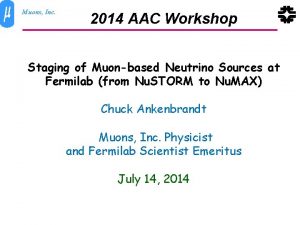17 th Advanced Accelerator Concepts Workshop AAC 2016


































![11/9/2020 Angle, q [rad ] Spectral Brightness [e. V-psec / (srad-e-)] Relativistic Thomson Backscattering 11/9/2020 Angle, q [rad ] Spectral Brightness [e. V-psec / (srad-e-)] Relativistic Thomson Backscattering](https://slidetodoc.com/presentation_image_h/7632b31bcaee39abf180d7e686955656/image-35.jpg)
















- Slides: 51

17 th Advanced Accelerator Concepts Workshop (AAC 2016) – National Harbor, MD Tutorial Particle Acceleration and Coherent Radiation Generation Phillip Sprangle University of Maryland Naval Research Laboratory 11/9/2020 AAC 2016 Tutorial (P. Sprangle) 1

Outline Laser Acceleration in Vacuum a) Crossed Laser Field Acceleration b) Cherenkov Acceleration c) Auto Resonance Cyclotron Acceleration Free Electron Laser Inverse Free Electron Laser Thermal and Coherent (Laser) Radiation 11/9/2020 AAC 2016 Tutorial (P. Sprangle) 2

Laser Acceleration in Vacuum The very large fields associated with ultra short pulse lasers make them very attractive for laser based acceleration mechanisms • Laser fields: • Atomic fields: 11/9/2020 AAC 2016 Tutorial (P. Sprangle) 3

Example of Vacuum Acceleration in Crossed Laser Fields Both lasers are polarized in the plane of the screen Laser 1 Laser 2 Accelerating Field 11/9/2020 AAC 2016 Tutorial (P. Sprangle) 4

Axial Accelerating Electric Field Crossed Laser Beams Area under the curve is zero, no net acceleration when actual laser fields are employed 11/9/2020 AAC 2016 Tutorial (P. Sprangle) 5

What can be done to accelerate electrons in vacuum? (answer: violate the conditions for the L-W theorem) Slow down the phase velocity of the laser field i. e. , slow wave structure, Cherenkov accel, etc. Introduce transverse motion to the electrons Cylcotron auto-resonance accel. Laser beat wave accel. Inverse free electron laser 11/9/2020 AAC 2016 Tutorial (P. Sprangle) 6

Vacuum Acceleration by Slowing Down the Accelerating Wave The particle is accelerated by the transmitted field which is in vacuum when there is total internal reflection of the laser field in the dielectric vacuum 11/9/2020 AAC 2016 Tutorial (P. Sprangle) 7

Vacuum Acceleration by Slowing Down the Accelerating Wave vacuum 11/9/2020 AAC 2016 Tutorial (P. Sprangle) 8

Another way to violate the L-W theorem Auto Resonance Electron Cyclotron Acceleration By introducing a static magnetic field together with a laser field electrons can be accelerated in vacuum In the absence of the laser field the magnetic field can’t change the particle's energy but it does change the direction of motion which can result in a resonance and acceleration 11/9/2020 AAC 2016 Tutorial (P. Sprangle) 9

Auto Resonance Electron Cyclotron Wave Acceleration Electrons are streaming and gyrating in a uniform magnetic field together with an electromagnetic wave which is propagation in the z direction 11/9/2020 AAC 2016 Tutorial (P. Sprangle) 10

Auto Resonance Electron Cyclotron Acceleration 11/9/2020 AAC 2016 Tutorial (P. Sprangle) 11

Auto Resonance Electron Cyclotron Wave Acceleration 11/9/2020 AAC 2016 Tutorial (P. Sprangle) 12

Auto Resonance Electron Cyclotron Wave Acceleration Rate of change of kinetic energy 11/9/2020 AAC 2016 Tutorial (P. Sprangle) 13

Auto Resonance Electron Cyclotron Wave Acceleration A CO 2 laser can be used to accelerate electrons 11/9/2020 AAC 2016 Tutorial (P. Sprangle) 14

Auto Resonance Electron Cyclotron Wave Acceleration Diffracting Laser Beam Synchrotron radiation places a limit on the maximum energy 11/9/2020 AAC 2016 Tutorial (P. Sprangle) 15

Auto Resonance Electron Cyclotron Wave Acceleration Diffracting Laser Beam 11/9/2020 AAC 2016 Tutorial (P. Sprangle) 16

Larmor’s Formula The total instantaneous power radiated by an accelerating charge is 11/9/2020 AAC 2016 Tutorial (P. Sprangle) 17

Radiation from Multiple Charges Consider a beam of individual charges all having the same trajectory 11/9/2020 AAC 2016 Tutorial (P. Sprangle) 18

Radiation from Multiple Charges Consider three cases a) charges flow in uniformly b) charges flow in randomly c) charges are highly bunched a) charges flow in uniformly 11/9/2020 AAC 2016 Tutorial (P. Sprangle) 19

Radiation from Multiple Charges b) charges flow in randomly 11/9/2020 c) charges are highly bunched AAC 2016 Tutorial (P. Sprangle) 20

Radiation from Multiple Charges c) for a highly bunched beam , i. e. , For uniformly distributive charges the radiated power is ~ 0 11/9/2020 AAC 2016 Tutorial (P. Sprangle) 21

Free Electron Lasers • The FEL is a radiation source based on classical physics. It utilizes a highly relativistic beam of electrons (active medium) which propagates in a transverse, spatially periodic magnetic field (pump). The interaction between the electron beam and periodic magnetic field results in coherent amplification of electromagnetic radiation • FELs use a relativistic electron beam as the lasing medium which propagates through a periodic magnetic field (pump) 11/9/2020 AAC 2016 Tutorial (P. Sprangle) 22

Reflecting EM Waves off a Moving Mirror mirror • In the case of a static periodic magnetic field the FEL frequency is up shifted by • Transformation of fields In mirror frame • For 11/9/2020 AAC 2016 Tutorial (P. Sprangle) 23

Reflecting EM Waves off an Array of Relativistically Moving Mirrors Coherent Backscattering λ mirror Incident EM wave (wiggler) The wiggler field looks like an EM wave in the electrons rest frame backscattered modulated electron beam gives coherence Doppler up shift in frequency Frequency-upshifted backscattered wave can be coherent if the partially reflecting mirrors are spaced a wavelength apart, e. g. , modulated electron beam 11/9/2020 AAC 2016 Tutorial (P. Sprangle) 24

Free Electron Lasers Amplifier Configuration • Radiation wavelength: Doppler shifted Electron axial velocity • FEL efficiency can be enhanced by detuning the beam energy or tapering the magnetic field (wiggler) period and/or amplitude 11/9/2020 AAC 2016 Tutorial (P. Sprangle) 25

Free Electron Laser Electron Beam Bunching Mechanism in the FEL relativistic electron beam wiggler field output radiation 11/9/2020 AAC 2016 Tutorial (P. Sprangle) 26

Axial Electron Bunching in FELs x wiggler Poynting flux electron beam z y radiation • Force on electron: • Wiggler field: wiggler • FEL radiation: AAC 2016 Tutorial (P. Sprangle) 11/9/2020 27

Axial Electron Bunching in FELs • The axial force on electrons (bunching wave) plus many other non-resonant terms • • To extract kinetic energy , beam velocity ~ phase velocity of the bunching wave which is equivalent to 28 11/9/2020 AAC 2016 Tutorial (P. Sprangle)

High-Gain FEL Mechanism e-beam frame • Electrons are longitudinally bunched by ponderomotive wave associated with • Beam velocity is slightly greater than phase velocity of ponderomotive wave, resulting in a phase shift (de-acceleration) • Electrons give up kinetic energy to the FEL radiation field, which further bunches the electrons • Feedback results in exponential gain (instability) • Instability saturates when electrons become trapped in the ponderomotive wave and are accelerated 11/9/2020 Pictures from Mc. Neil and Thompson, Nature Photonics 4, 814 (2010) AAC 2016 Tutorial (P. Sprangle) 29

Optical Guiding and Gain of FEL Radiation Optical guiding is an intrinsic part of the FEL mechanism FEL wavenumber: 11/9/2020 AAC 2016 Tutorial (P. Sprangle) 30

FEL Gain and Optical Guiding Refractive index: • Growing wave (G > 0) implies Dk > 0 FEL radiation can be optically guided Wave fronts e-beam 11/9/2020 AAC 2016 Tutorial (P. Sprangle) 31

Simulations of a 2. 1 μm FEL Amplifier Gain and Saturation (GENESIS ) E-beam Rb(0) = 271 mm (rms) g(0) = 145 bunch duration = 0. 5 psec (rms) emittance = 12 mm-mrad peak current = 800 A bunch charge = 1 n. C energy spread = 0. 3% Radiation l. R = 2. 141 μm RL(0) = 0. 4 mm P(0) = 100 W (cw) Wiggler lw = 3 cm Bw(0) = 8. 6 k. G 11/9/2020 AAC 2016 Tutorial (P. Sprangle) 32

Far Field of Phase Array of Electric Dipole Radiators Array of oscillating dipoles (bunched electron beam) z Directed Radiation Pattern Forward going fields add while backward going field interfere Stationary dipole 11/9/2020 AAC 2016 Tutorial (P. Sprangle) 33

Amplified Spontaneous Radiation in FELs • Relativistic Thompson backscattering provides the seed radiation x electron radiation z y Wiggler field • Radiated energy per solid angle per frequency is 11/9/2020 AAC 2016 Tutorial (P. Sprangle) 34
![1192020 Angle q rad Spectral Brightness e Vpsec srade Relativistic Thomson Backscattering 11/9/2020 Angle, q [rad ] Spectral Brightness [e. V-psec / (srad-e-)] Relativistic Thomson Backscattering](https://slidetodoc.com/presentation_image_h/7632b31bcaee39abf180d7e686955656/image-35.jpg)
11/9/2020 Angle, q [rad ] Spectral Brightness [e. V-psec / (srad-e-)] Relativistic Thomson Backscattering Incoherent X-Ray Spectrum X- Ray Energy [ke. V] AAC 2016 Tutorial (P. Sprangle) 35

Spectral Overlap of Incoherent and Growth Rate Spectrum FEL growth rate spectrum, exp[ 2 Γ(ω, θ) z ] incoherent radiation spectrum S(ω, θ, z) incoherent photons in the overlap region undergo growth leading to coherent radiation 11/9/2020 AAC 2016 Tutorial (P. Sprangle) 36

Transition from Incoherent to Coherent FEL Radiation incoherent electron beam z 11/9/2020 AAC 2016 Tutorial (P. Sprangle) 37

Inverse Free Electron Laser In the FEL the kinetic energy in the relativistic electron beam is converted into coherent radiation energy In the inverse FEL the energy in a coherent radiation beam is converted into kinetic energy in the relativistic electron 11/9/2020 AAC 2016 Tutorial (P. Sprangle) 38

Thermal and Laser Radiation Emitters (atoms) Cavity The field amplitude on the z=0 plane due to all the emitters can be written in the form The actual field is the real part of the above expression The emitters are assumed to have the same central frequency ω0 , and fixed polarization 11/9/2020 AAC 2016 Tutorial (P. Sprangle) 39

Thermal Radiation Source 11/9/2020 AAC 2016 Tutorial (P. Sprangle) 40

Thermal radiation source 11/9/2020 AAC 2016 Tutorial (P. Sprangle) 41

Differences Between Thermal and Laser Radiation The average intensity (averaged over the optical period) at z = 0 11/9/2020 AAC 2016 Tutorial (P. Sprangle) 42

Thermal Radiation In the case of thermal radiation the intensity fluctuates randomly on a time comparable to the coherence time (Gaussian power spectrum) 11/9/2020 AAC 2016 Tutorial (P. Sprangle) 43

Thermal Radiation (Lorentzian power spectrum) 11/9/2020 AAC 2016 Tutorial (P. Sprangle) 44

Power Spectrum 11/9/2020 AAC 2016 Tutorial (P. Sprangle) 45

Differences Between Thermal and Laser Radiation Single mode (Longitudinal mode) laser source 11/9/2020 AAC 2016 Tutorial (P. Sprangle) 46

Differences Between Thermal and Laser Radiation Single mode laser source 11/9/2020 AAC 2016 Tutorial (P. Sprangle) 47

Differences Between Thermal and Laser Radiation Single mode laser source 11/9/2020 AAC 2016 Tutorial (P. Sprangle) 48

Differences Between Thermal and Laser Radiation 11/9/2020 AAC 2016 Tutorial (P. Sprangle) 49

Differences Between Thermal and Laser Radiation Single mode laser source The intensity at z = 0 11/9/2020 AAC 2016 Tutorial (P. Sprangle) 50

Back Up Slides 11/9/2020 AAC 2016 Tutorial (P. Sprangle) 51
 No tech aac examples
No tech aac examples Tertiary aac assessment centre
Tertiary aac assessment centre Aac goals
Aac goals Aac sig
Aac sig Aac and apraxia
Aac and apraxia 18 aac 75
18 aac 75 Crooked house aac
Crooked house aac Just in time programming aac
Just in time programming aac Aac armament
Aac armament Aac
Aac Coverage vocabulary aac
Coverage vocabulary aac Aac implementation plan
Aac implementation plan Aac implementation plan
Aac implementation plan Augmentative and alternative communication profile
Augmentative and alternative communication profile Tips for augmentative and alternative communication success
Tips for augmentative and alternative communication success Aac drm hal
Aac drm hal It-aac
It-aac Winamp aac encoder
Winamp aac encoder Aac evaluation genie
Aac evaluation genie Advanced higher music concepts
Advanced higher music concepts Advanced sql concepts
Advanced sql concepts Association analysis advanced concepts
Association analysis advanced concepts Php advanced concepts
Php advanced concepts Chapter 9 kumar steinbach tan
Chapter 9 kumar steinbach tan Association rules in data mining
Association rules in data mining Advanced software testing concepts
Advanced software testing concepts Association analysis advanced concepts
Association analysis advanced concepts Association analysis advanced concepts
Association analysis advanced concepts Association analysis advanced concepts
Association analysis advanced concepts Association analysis advanced concepts
Association analysis advanced concepts Stanford linear accelerator tours
Stanford linear accelerator tours Compost accelerator homebase
Compost accelerator homebase Cern accelerator complex
Cern accelerator complex Dating
Dating Ipmi architecture
Ipmi architecture Accelerator forced rescan
Accelerator forced rescan Dielectric wall accelerator
Dielectric wall accelerator Salesforce cpq accelerator
Salesforce cpq accelerator Charter network accelerator
Charter network accelerator Microsoft virtual machine converter download
Microsoft virtual machine converter download Offshore wind accelerator
Offshore wind accelerator Transformational leadership questionnaire (tlq)
Transformational leadership questionnaire (tlq) Dielectric laser accelerator
Dielectric laser accelerator Tca accelerator drops directions
Tca accelerator drops directions Bugorski
Bugorski Growth accelerator coach
Growth accelerator coach Coherent accelerator processor interface
Coherent accelerator processor interface Fiscal policy ib economics
Fiscal policy ib economics Netbackup accelerator
Netbackup accelerator Loa accelerator
Loa accelerator Accelerator for r&d
Accelerator for r&d United way social innovation accelerator
United way social innovation accelerator




